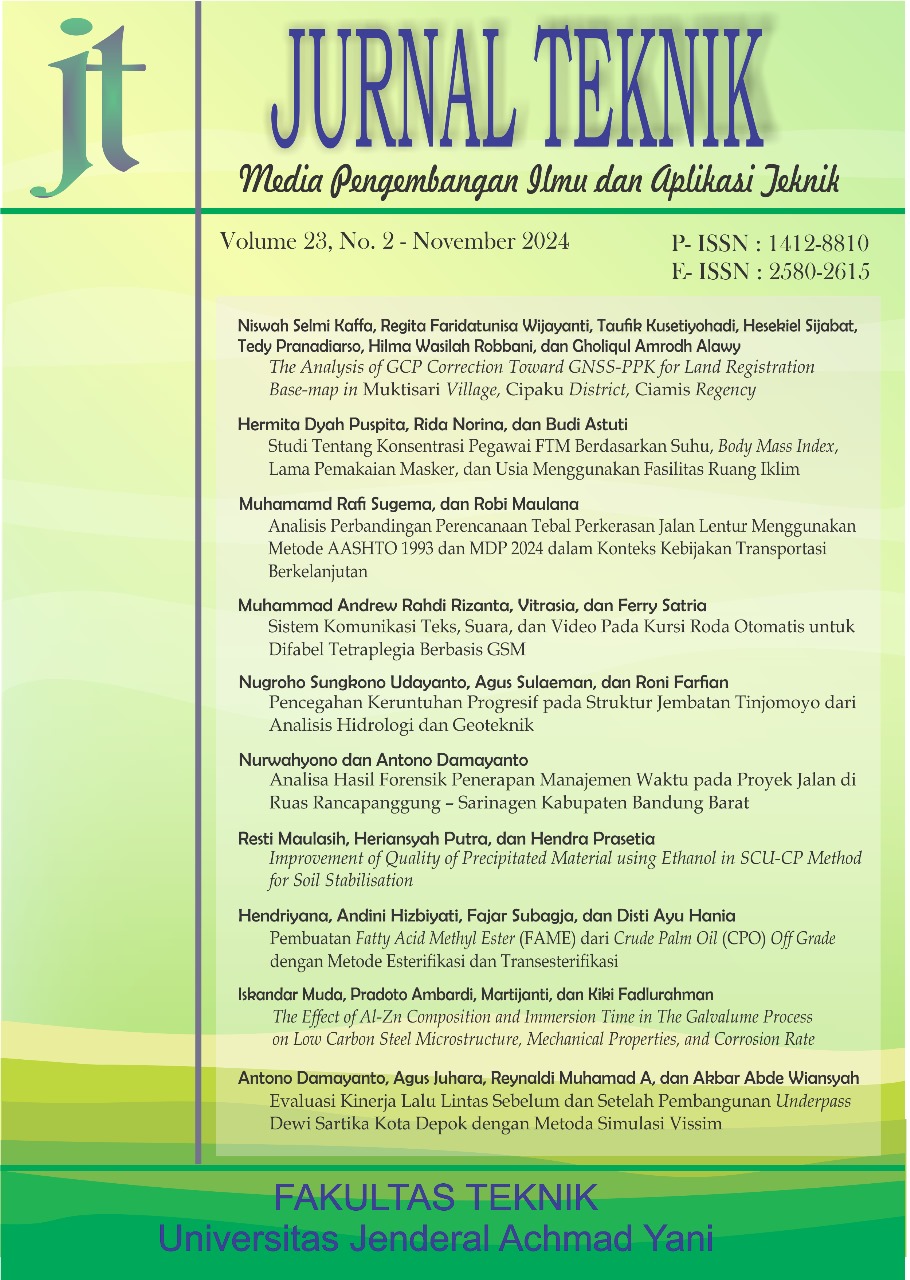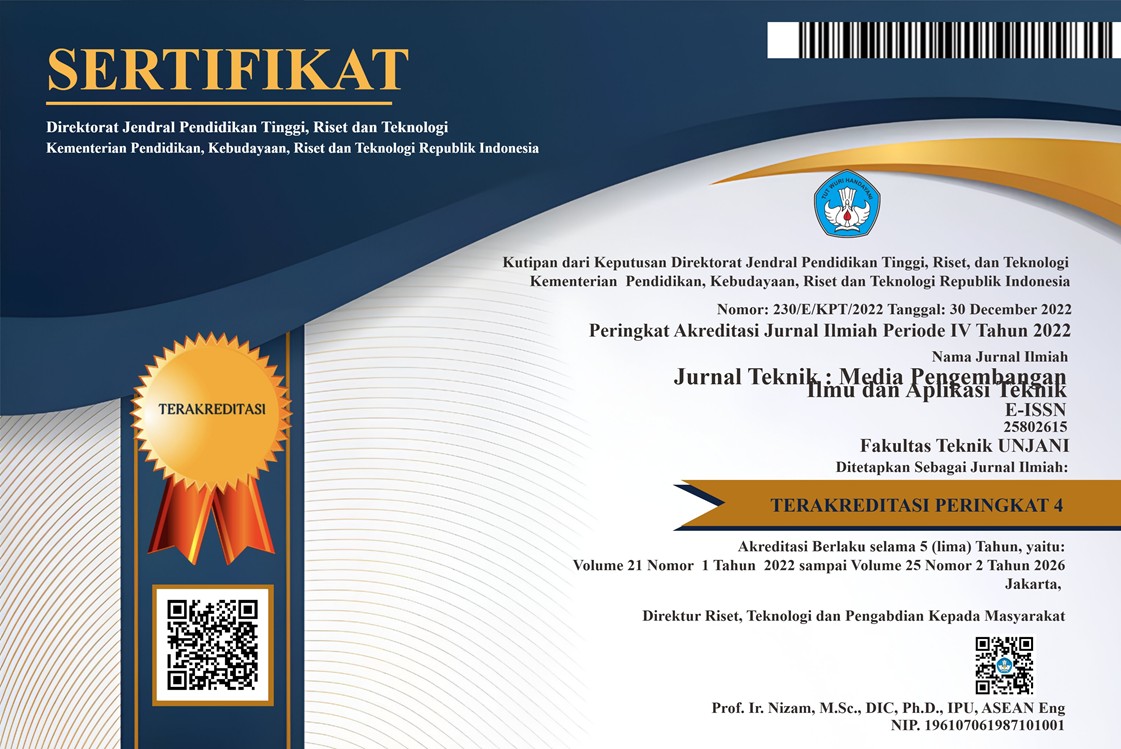The Analysis of GCP Correction Toward GNSS-PPK for LandRegistration Base-map in Muktisari Village, Cipaku District, Ciamis Regency
DOI:
https://doi.org/10.55893/jt.vol23no2.571Keywords:
GNSS-PPK, Ground Control Point, Basemap, PhotogrammetryAbstract
The Comprehensive Systematic Land Registration Program (PTSL) main requirement is land registration map in a scale of 1:1000 and horizontal accuracy (CE90) class 1 of 0,3 meters. Global Navigation Satellite System–Post Processing Kinematic (GNSS-PPK) provides good accuracy without Ground Control Point (GCP) correction, thus reducing cost and data acquisition time. GNSS-PPK without GCP correction is considered accurate in areas <500 meters elevation. This research aims to determine the GCP correction importance for photo accuracy in PPK process. This study analyzes aerial photo accuracy with and without GCP correction in areas with elevations from 200 to 430 meters. The data required are aerial photos, coordinates in RINEX files, Digital Terrain Model (DTM), and 8 GCP points. Coordinate files are calculated using the PPK method then used for photo correction. Photos are processed with and without GCP correction. Photo without GCP correction has a significant deviation than photo with GCP correction and does not meet the CE90 requirements. The accuracy has a negative correlation with an elevation of -0,041 without GCP and -0,76 with GCP. This study proves that GNSS-PPK method still requires GCP and it is not proven deviation in data without the GCP correction is directly proportional to elevation.
References
Carvajal-Ramirez, Fernando., Aguera-Vega, Francisco., Martinez-Carricondo, Patricio J (2016) Effect of image orientation and ground control points distribution on unmanned aerial vehicle photogrammetry project on a road cut slope. J. Appl. Remote Sens. 10(3), 034004
De Leeuw, A.j., Veugen, L.M.M., Van Stokkom, H.T.C (1988) Geometric correction remotely-sensed imagery using ground control points and orthogonal polynomial, International Journal of Remote Sensing, 9:10-11, 1751-1759
Dinkov, Davis., Kitev, Atanas (2020) Advantages and applicability of GNSS post-processing kinematic (PPK) method for direct georeferencing of UAV images. Proceeding Vol. 1, 8th International Conference on Cartography and GIS
Eker, Remzi., Alkan, Ece., Aydin, Abdurrahim (2021) A comparative analysis of UAV-RTK and UAV-PPK methods in mapping different surface types. Eur J Forest Eng, 7(1): 12-25
James, M.R., Robson, S. and Smith, M.W (2017) 3-D uncertainty-based topographic change detection with structure-from-motion photogrammetry: precision maps for ground control and directly georeferenced surveys. Earth Surf. Process. Landforms, 42(12), 1769-1788
Junarto, R. and D. Djurjani (2020). "Pemanfaatan Teknologi Unmanned Aerial Vehicle (UAV) untuk Pemetaan Kadaster." BHUMI: Jurnal Agraria dan Pertanahan 6(1).
Kecamatan Cipaku dalam Angka (2020) Badan Pusat Statistik Kabupaten Ciamis (Indonesian Central Statistic Bureu) https://tanahair.indonesia.go.id (access: January 2023)
Konecny, G (1976) Mathematische Modelle und Varfahren zur geometrischen Auswertung von Zeilenabtaster-Aufnahmen. Bildmessung und Luftbildwesen, 44, 188-197.
McKenna, S., et al. (2016). "s-CorrPlot: An Interactive Scatterplot for Exploring Correlation." Journal of Computational and Graphical Statistics 25(2): 445-463.
Mian, O., Lutes, J., Lipa, G., Hutton, J.J., Gavelle, E., Borghini, S (2015) Direct georeferencing on small unmanned aerial platforms for improved reliability and accuracy of mapping without the need for ground control points. The International Archives of the Photogrammetry, Remote Sensing and Spatial Information Science, Volume XL-1/W4
Nagendran, S. K., et al. (2018). "Accuracy assessment on low altitude UAV-borne photogrammetry outputs influenced by ground control point at different altitude." IOP Conference Series: Earth and Environmental Science 169.
Reimann, C., et al. (2017). "A new method for correlation analysis of compositional (environmental) data - a worked example." Sci Total Environ 607-608: 965-971.
Siebert, S. and J. Teizer (2014). "Mobile 3D mapping for surveying earthwork projects using an Unmanned Aerial Vehicle (UAV) system." Automation in Construction 41: 1-14.
Taddia Y, Stecchi F, Pellegrinelli A (2020) Coastal mapping using DJI Phantom 4 RTK in post-processing kinematic mode. Drones 4: 9
Tomastik, J., Mokros, M., Surovy, P., Grznarova, A., Merganic, J (2019) UAV RTK/PPK method-An optimal solution for mapping inaccessible forested areas? Remote Sensing, 11: 721
Wijayanti, R. F., et al. (2023). "Utilizing Post Processing Kinematic (Ppk) Unmanned Aerial Vehicle (Uav) to Accelerate Detailed Land Mapping." Jurnal Geosaintek 9(3).
Zhang, D. (2017). "A Coefficient of Determination for Generelized Linear Models." The American Statistican 71:4: 310-316.
Zhang, H., Aldana-Jague, E., Clapuyt, F., Wilken, F., Vanacker, V., Van Oost, K., (2019) Evaluating the potential of post-processing kinematic (PPK) georeferencing for UAV-based structure-from-motion (SfM) photogrammetry and surface change detection. Earth Surf Dyn, 7: 807-827.
Additional Files
Published
Issue
Section
License
Copyright (c) 2025 Niswah Selmi Kaffa, Regita Faridatunisa Wijayanti, Taufik Kusetiyohadi, Hesekiel Sijabat, Tedy Pranadiarso, Hilma Wasilah Robbani, Gholiqul Amrodh Alawy

This work is licensed under a Creative Commons Attribution-NonCommercial-ShareAlike 4.0 International License.
Penulis yang menyerahkan artikel di Jurnal Teknik: Media Pengembangan dan Aplikasi Teknik untuk keperluan publikasi telah mengetahui bahwa Jurnal Teknik: Media Pengembangan dan Aplikasi Teknik memberikan akses terbuka terhadap konten untuk mendukung pertukaran informasi mengenai ilmu pengetahuan, sesuai dengan penerbitan daring yang berbasis Open Access Journal dan mengikuti Creative Commons Attribution 4.0 International License. Sehingga penulis setuju dengan ketentuan-ketentuan berikut:
1. Penulis memegang hak cipta dan memberikan hak publikasi pertama kepada pihak jurnal dengan pekerjaan secara bersamaan
di bawah Creative Commons Attribution 4.0 International License yang memungkinkan orang lain untuk berbagi pekerjaan
dengan pengakuan kepengarangan karya dan publikasi pertama artikel tersebut di Jurnal Teknik: Media Pengembangan dan
Aplikasi Teknik.
2. Penulis dapat melakukan perjanjian tambahan untuk hak distribusi non-eksklusif artikel yang telah diterbitkan di jurnal ini
(misalnya, posting ke sebuah repositori institusi atau menerbitkannya dalam sebuah buku), dengan mengakui bahwa
publikasi pertama dilakukan di Jurnal Teknik: Media Pengembangan dan Aplikasi Teknik.
3. Penulis diizinkan dan didorong untuk menyebarkan karya mereka secara daring (misalnya, dalam repositori institusi atau
laman web penulis) setelah artikel terbit (proses penerbitan artikel selesai). Hal ini terkait dengan imbas dari pertukaran
informasi yang produktif (Lihat Pengaruh Open Access).












